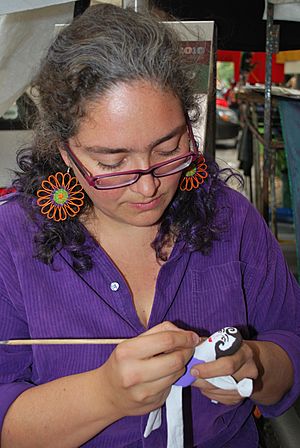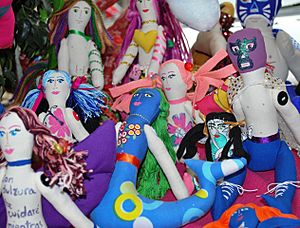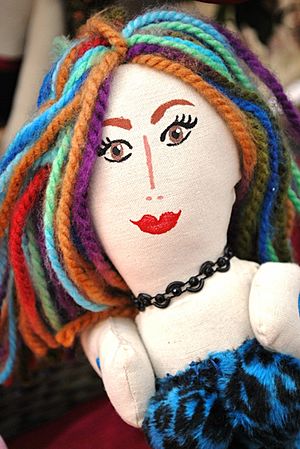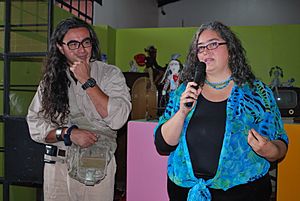Ana Karen Allende facts for kids
Quick facts for kids
Ana Karen Allende
|
|
|---|---|

Ana Karen Allende painting a doll
|
|
| Born |
Coyoacán
|
| Nationality | Mexican |
| Known for | Cloth dolls and figures |
Ana Karen Allende is a talented Mexican artisan from Mexico City. She lives in a part of the city called Coyoacán. Ana Karen is famous for making amazing rag dolls and soft fabric animals.
Making rag dolls is a very old tradition in Mexico. It goes back to ancient times! This craft became super popular in the 1800s. Ana Karen made her very first doll for her sister's fifteenth birthday, a special celebration called a quinceañera. In some places, like Xochimilco, girls get a "last doll" at their quinceañera. This doll shows they are growing from a child into a young adult.
Ana Karen learned how to sew from her grandmother. Soon, she was making dolls for all her friends and family. Everyone loved them so much that she decided to start selling them! In 2002, she started her own small business called Retacitos, which means "Scraps." Her family helps her, and she even hires single mothers in her area.
You can find Ana Karen selling her unique creations directly to people every Saturday. She sets up her stand at the Art Bazaar in the San Ángel neighborhood. She also sells her dolls to stores and museums. Sometimes, people ask her to make custom dolls that look like famous people, like Frida Kahlo, or even like themselves! Ana Karen wants to keep the art of doll making alive, but with a modern twist. She often creates dolls that represent Mexican culture, like lucha libre wrestlers, angels, and mermaids.
Since 2010, the government of Mexico City has recognized her as a true Mexican craftswoman. Her beautiful work has been shown in many museums and cultural events. She has also won several awards, including first place in the toy category at the Gran Premio de Arte Popular of FONART in 2006.
Contents
The History of Mexican Dolls
The tradition of making dolls in Mexico is very old. We know this because small clay dolls with movable arms and legs have been found in ancient cities like Teotihuacan. Even though toys have been made for a long time, many old ones are in poor condition. This is because they were made from natural materials that break down over time.
Today, people in many communities, especially in places like Chiapas and Oaxaca, still make handcrafted dolls. They use different materials, but cloth and ceramic dolls are the most common. Rag dolls became especially popular in Mexico during the 19th century.
Ana Karen's Creative Journey
Ana Karen's grandmothers taught her how to knit and embroider. Her great-grandmother showed her and her sister, Lorena, how to paint and decorate their toys. Her mother always encouraged them to create their own toys from anything they could find! This sparked Ana Karen's interest in painting and drawing. She even took lessons when she was a teenager.
Her grandparents lived in the center of Coyoacan, a place where many artisans sell their crafts. This allowed Ana Karen to meet them and learn new skills, like working with wire. Her grandmother also taught her to sew using an old Singer sewing machine from the late 1800s. This was the machine she used to make her first two dolls.
When Ana Karen moved to Xochimilco, she became part of the local culture. She joined in weddings, festivals, and quinceañeras. Her younger sister was about to turn fifteen. In Xochimilco, it's a tradition for a girl to receive her "last doll" from her godparents at her quinceañera. This doll is a symbol of her journey from childhood to adulthood. These special dolls often have high heels instead of flat shoes. Ana Karen decided to make this important doll for her sister herself.
This project made Ana Karen want to learn more about the history of rag dolls in Mexico. Soon, she was making dolls as gifts for her family and friends. Everyone loved them so much that she thought about selling them. One of her first items for sale was stuffed rabbits.
She started making and selling rag dolls and stuffed animals in 2002. Her first goal was to make the "last dolls" for quinceañeras. Her mother-in-law, who worked with paper crafts, introduced her to many other artisans. This helped Ana Karen find more customers. Since then, she has continued to develop her craft. She wants to bring back the tradition of Mexican handcrafted dolls and stuffed animals, but with new and modern ideas.
Unique Creations
Ana Karen believes that store-bought dolls and stuffed animals often feel impersonal. She says they are just copies. Her creations are special because each one is unique; no two are exactly alike!
Some of her most popular figures are inspired by lucha libre wrestlers, like Blue Demon and El Santo. She also makes figures from Mexico's past, such as aluxes (small magical beings) and calacas (skeletons often seen during Day of the Dead). Her work also includes dolls of the famous painter Frida Kahlo and creatures that look like alebrijes (colorful fantasy animals). She also creates traditional rag dolls, fairies, horses, and mermaids.
Ana Karen says that, except for custom orders, all her pieces are based on Mexican culture and traditions. She doesn't use characters from popular culture outside of Mexico. Instead, she focuses on figures that are well-known in Mexican handcrafts and folk art.
She has even made dolls that look like famous people and her own customers. For example, she created a doll of the singer Cecilia Toussaint for her business, Retacitos. This doll was used to open one of the singer's shows! She also made a life-sized doll of the writer Julio Cortázar, complete with his cat and a cigarette. When she gets an order like this, she researches the person to learn more about them.
Retacitos: A Family Business
Since 2003, Ana Karen has sold her beautiful creations every Saturday. You can find her at the San Ángel art and handcrafts bazaar in San Jacinto Plaza. Her work is sold under the name Retacitos, which means "scraps." This small family business has been officially registered since 2005.
The Retacitos team also works with other people, often single mothers. These contractors can work from home and take care of their children. The name "Retacitos" came from the idea that most homes have small bits of cloth, string, and other items. These scraps can be used to make dolls and other creative things. Sadly, much of this material is wasted today because many people no longer know how to sew.
The business has worked hard to sell their products in more places. You can find Retacitos items in Mexico City, Cancún, and Nayarit. Ana Karen has also worked with universities to help her business grow. Retacitos sells directly to the public only in San Angel on Saturdays. Other sales happen through stores like those in the Museo de Arte Popular and the Museo Mexicano del Diseño.
Exhibitions and Awards
Ana Karen and her team have shown their Retacitos projects in many parts of Mexico and even in other countries. Their work has been displayed in museums, art galleries, fairs, and cultural centers. They have also been interviewed by newspapers, TV shows, and online media.
With help from a government agency called FONDESO, Retacitos has participated in exhibitions at the World Trade Center. Their work has been shown in countries like Germany, Canada, France, and Spain. Ana Karen's art has been featured in the Museo Dolores Olmedo and the Museo de Arte Popular. It has also been part of festivals, like the Festival de las Almas in Valle de Bravo.
For the Festival de las Almas, Ana Karen created a special set of dolls related to Mexico's Day of the Dead. The exhibit was called "From the beyond with a soul of rags." It included about fifty pieces, like mobiles and toys, all about death and Mexican popular culture. In March 2012, she had her own exhibition for International Women's Day. It was called "Scraps with the Gaze of a Woman."
One of her cloth artworks, called "Yaxché, the Mayan sacred tree," is part of a collection in France. This piece was also shown in an exhibition called "Textile Magic" in Mexico City in May 2011.
Ana Karen won first prize in the toy category at the Gran Premio de Arte Popular FONART in 2006. She is also certified by the government as a true Mexican artisan. In 2007, her work was shown in the Museo del Estanquillo. This exhibit included a meter-tall Judas figure and a life-sized doll of Frida Kahlo. These pieces now belong to the writer Iván Restrepo.
Her artwork, "Will Fight For Your Dreams," which has a lucha libre theme, won third place out of sixty entries at the VI Bienal Internacional de Arte Textil.
See also
 In Spanish: Ana Karen Allende para niños
In Spanish: Ana Karen Allende para niños
- CNN report on Karen's work




